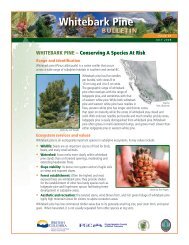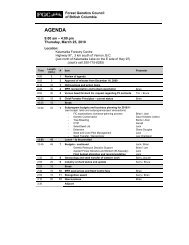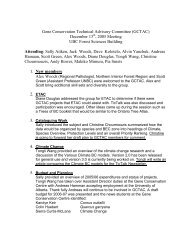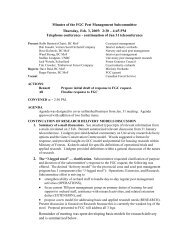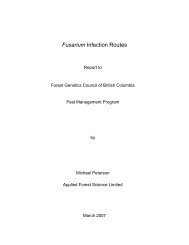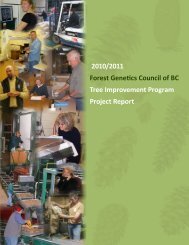Tree Improvement Program Project Report 2006 / 2007
Tree Improvement Program Project Report 2006 / 2007
Tree Improvement Program Project Report 2006 / 2007
Create successful ePaper yourself
Turn your PDF publications into a flip-book with our unique Google optimized e-Paper software.
.2.17 Development of Yellow-Cedar<br />
Stock Plant Nutr t on Gu del nes<br />
to Enhance Operat onal<br />
Root ng of El te Clones<br />
(SPU 111 )<br />
Robert van den Dr essche<br />
Yellow-cedar reforestation in BC is almost entirely through<br />
clonal forestry using rooted cuttings. For example, the<br />
Ministry of Forests and Range Cowichan Lake Research<br />
Station grows stock plants chosen from selected yellowcedar.<br />
These yellow-cedar plants have been selected because<br />
they have shown superior growth in the forest and also<br />
good ability to root from cuttings. The stock plants are<br />
grown outdoors, either in pots or field-planted, and are<br />
kept small by pruning because pruning, or “hedging,” tends<br />
to slow the aging process. Slowing aging and maintaining<br />
juvenility is important for producing cuttings that grow like<br />
seedlings. That is, they root easily and have vigorous shoot<br />
growth. Research studies at CLRS have shown that serial<br />
propagation by using a proportion of each generation of<br />
rooted cuttings as hedges for the next generation conserves<br />
juvenility for about 15 years.<br />
Recent operational experience indicates the potential<br />
benefit of growing stock plants in greenhouses for<br />
increasing the rooting of cuttings. This benefit may, in part,<br />
be attributed to a more optimal nutrient status for rooting<br />
ability among stock plants. Little is known about the effect<br />
of yellow-cedar stock plant nutrition on the rooting ability<br />
of cuttings, although nutrition is relatively easy to control<br />
and stock plant nutrition has been shown to influence the<br />
performance of cuttings in plants.<br />
In particular, the balance between concentrations of<br />
total non-structural carbohydrates and nitrogen has been<br />
thought important for rooting, although the relationship of<br />
cutting performance to several nutrients has been reported.<br />
Additionally, production by the WFP Saanich nursery of<br />
yellow-cedar cuttings that rooted and grew vigorously was<br />
attributed to adding fertilizer to the stock plants during the<br />
fall. Consequently, we decided to study the importance of<br />
nitrogen and phosphorus, and the time of their application,<br />
to potted stock plants of different clones and ages at<br />
the CLRS. The objective is to relate different levels of<br />
nutrient status in stock plants, achieved with the fertilizer<br />
treatments, to subsequent rooting and growth vigour of<br />
cuttings. It should then be possible to recommend levels<br />
T R E E I M P R O V E M E N T P R O G R A M<br />
P R O J E C T R E P O R T 2 0 0 6 / 2 0 0 7<br />
of stock plant nutrient status for the successful production<br />
of cuttings. So far, a small-scale experiment has produced<br />
cuttings that have been struck this winter, and samples<br />
of these cuttings are undergoing chemical analysis. Also<br />
plant material has been potted and prepared for a larger<br />
experiment that will be conducted during <strong>2007</strong> and 2008.<br />
.2.1 Fert l ty Var at on n a Douglasfir<br />
Seed Orchard as Determ ned<br />
by DNA F ngerpr nt ng: an<br />
Update<br />
Ben La , Annette Van N ejenhu s, and<br />
Yousry A. El-Kassaby<br />
Because seed orchards represent the main sources of<br />
genetically improved seed for most artificially regenerated<br />
forests, they play an important interface role between tree<br />
breeding and silvicultural activities. The production of seed<br />
crops with high genetic quality (gain and diversity) in all<br />
BC orchards is critical to the success of tree improvement<br />
programs and to meeting the genetic quality required under<br />
the Chief Forester’s Standards for Seed (2005).<br />
This project is part of a larger initiative started by the<br />
BC Ministry of Forests and Range, the forest industry,<br />
and academia aimed at obtaining accurate estimates of the<br />
genetic quality of seedlots. Genetic quality is defined as the<br />
level of genetic gain combined with the degree of genetic<br />
diversity. Orchard managers routinely assess these estimates,<br />
and estimates such as genetic worth (GW) and effective<br />
population size (N e ) are an integral part of the evaluation of<br />
seed-orchard crops.<br />
DNA fingerprinting technology coupled with methods<br />
of pedigree reconstruction will be used to obtain accurate<br />
estimates of the genetic contribution to a specific seedlot<br />
of each parent in Western Forest Products’ Douglas-fir seed<br />
orchard. These estimates will be compared with survey<br />
assessment methods that are based on visual inspection<br />
of trees’ reproductive output. Additionally, the use of<br />
DNA technology will permit the estimation of pollen<br />
contamination from outside sources and the effectiveness of<br />
orchard management practices such as supplemental mass<br />
pollination (SMP) and over-head cooling (bloom delay).<br />
71



